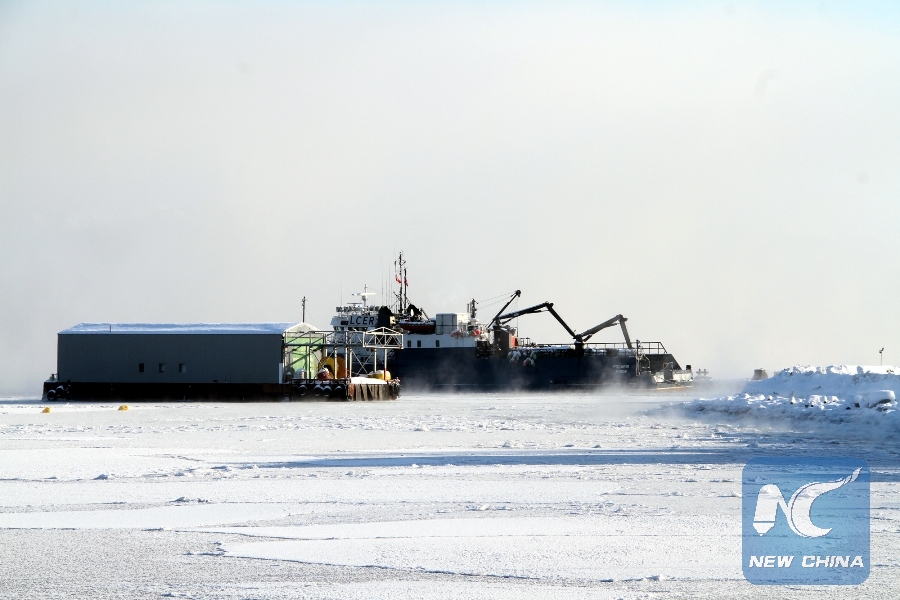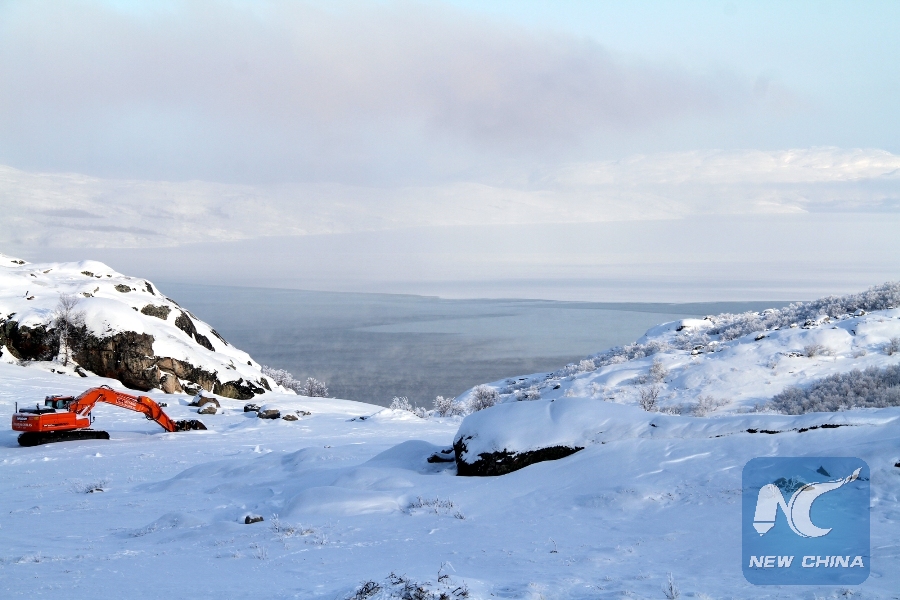
Photo taken on March 9, 2018, shows a ship at a dock in the Arctic town of Kirkenes, Norway. (Xinhua/Liang Youchang)
by Liang Youchang, Zhang Shuhui
KIRKENES, Norway, March 9 (Xinhua) -- Envisioning a new port on the Barents Sea coast and a railway that goes all the way southward to the Baltic Sea, Norway's Arctic town of Kirkenes sets its sight on a major European hub on a Polar Silk Road with link to China.
Finland and Norway announced on Friday plans to explore building an Arctic railway between Finland's northern city of Rovaniemi and Norway's ice-free port of Kirkenes.
This agreement came after Norway plans to develop new harbor and terminal areas near Kirkenes, a town in the Sor-Varanger municipality in Norway's northeastern county of Finnmark.
 Photo taken on March 9, 2018, shows a ship at a dock in the Arctic town of Kirkenes, Norway. (Xinhua/Liang Youchang)
Photo taken on March 9, 2018, shows a ship at a dock in the Arctic town of Kirkenes, Norway. (Xinhua/Liang Youchang)
A MAJOR ARCTIC HUB
"This project with railway connected to the Belt and Road Initiative through the Northern Sea Route and the Arctic strategy of China fits very well into all the plan for the huge 'Barents Harbor'," Rune Rafaelsen, mayor of the Sor-Varanger municipality, told Xinhua.
"Regarding logistic transport in the Arctic in the future, you are dependent on having a good railroad that could reach Europe fast and Kirkenes is the first (Western) port when you come from China," he said.
According to a study by the Finnish and Norwegian governments, the 520-km railway between Rovaniemi and Kirkenes would cost about 2.9 billion euros (3.6 billion U.S. dollars) and open in 2030.
It will form part of the proposed Arctic Corridor, which envisions cargo from Asia would be offloaded in Kirkenes and sent southward by railway to Finland, the Baltic states and the rest of Europe.
Local planners in Kirkenes have been lobbying the Norwegian town of Barents, 15 km west of the border with Russia, as the perfect site for a major hub linking the Arctic shipping route and the Arctic Corridor.
"The vision for The Arctic Railway is to be able to offer an environment-friendly and faster transport alternative for goods between Northeast Asia and Northern Europe via Finland by utilization of the Northern Sea Route and development of Kirkenes as a hub port," said a Norwegian report published in January.
The report titled An Arctic Railway Vision was a result of work between the development company Sor-Varanger Utvikling, the Kirkenes Business Park and the Finnmark County Council.
The voyage could be cut back 40 percent via the Northern Sea Route, the Arctic shipping course also known as the Northeast Passage, compared to the current route through the Suez Canal between Northern Europe and Northeast Asia, according to the report.
It would result in a 20 percent reduction in fuel consumption, it added.

Photo taken on March 9, 2018, shows the area of Hoybukta vest near the ARctic town of Kirkenes, Norway. Hoybukta vest is the site where Norway plans to develop new harbor and terminal areas. (Xinhua/Liang Youchang)
POLAR SILK ROAD TO CHINA
The report, which said the Arctic railway is potentially a new "maritime silk route in the north," was released just a few days before China published a white paper elaborating on its vision of a Polar Silk Road, an extension of the Belt and Road Initiative it proposed in 2013.
The Initiative's overland Silk Road Economic Belt and the 21st-Century Maritime Silk Road are expected to promote the connectivity of policy, infrastructure, trade, investment and people in areas involved to seek common development and prosperity.
The Initiative brings opportunities for parties concerned to jointly build a Polar Silk Road, and facilitate connectivity and sustainable economic and social development in the Arctic region, the white paper noted.
People in Kirkenes believe that China's interest in the development of the Arctic and its economic prospect are "very important" factors for the town's dream to come true.
"To realize these plans, we need lots of investment, and we also need cargo. So, without a good connection and a good cooperation with China, this project will never be done," Rafaelsen said.
"Cooperation between Norway and China is extremely important for transport and logistics in the Arctic," he said, citing the fact that seven of the world's top 10 container ports are now in China.
Kenneth Stalsett, CEO of the Sor-Varanger Utvikling company, said Sor-Varanger, a municipality of about 10,000 with 6,000 of them in the Kirkenes area, cannot itself suffice for a railroad.
"We are...basically nothing in the big picture," Stalsett said. "So we need to connect the world globally if this is going to happen."
He noted that the Arctic railway is dependent on an international interest in using the Arctic shipping route.
"The Chinese are sending ships. They are developing ships and talking about the Northern Sea Route in a positive way and the Arctic in a positive setting," Stalsett said.
"So I think without this the railroad will just be a dream in the future, but with it, it's absolutely doable and important," he said.

